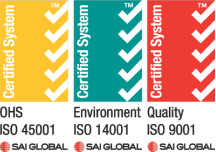a blog by Wagners CFT Key Account Manager, Darren Wilson
When you work around marine infrastructure for long enough, you see what saltwater can do. It doesn’t matter whether it’s steel, timber, or concrete, over time, the environment always wins. Corrosion, rot, and fatigue are relentless. That’s why, at Wagners Composite Fibre Technologies (CFT), we’ve spent years developing composite solutions that can truly stand the test of time in these harsh environments.
Our Fibre Reinforced Polymer (FRP) marine piles are designed to solve that problem once and for all offering long-term performance without the corrosion, rot, or heavy maintenance that comes with traditional materials.
And depending on the application, we offer two distinct types of marine piles:
- Our standard FRP Marine Pile — a circular hollow section designed for fixed structures or any installation where there’s no roller/guide movements and impact against the pile. IE from a floating structure.
- Our Trident Marine Pile — the same structural FRP pile, but with an integrated HDPE sleeve designed specifically for pontoons or floating systems where pile guides or equipment move up and down the pile.
Both are engineered for strength, longevity, and ease of installation but each is optimised for different site conditions. Here’s how they work, and how to choose between them.
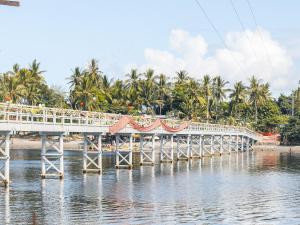
Lae Lae Bridge in Papua New Guinea
The Standard FRP Marine Pile – Lightweight, Corrosion-Free, and Built to Last
Our standard marine pile is a pultruded circular hollow FRP section that is precision-manufactured to provide high strength and stiffness with significantly less maintenance required compared to traditional materials.
The pultrusion process continuously draws glass fibres through a thermoset resin matrix, producing a solid structural member that’s strong in tension and compression, fatigue-resistant, and completely immune to corrosion, rot, and marine borer attack.
Typical design properties for our standard FRP CHS (Circular Hollow Section) include:
- Tensile strength: around 635 MPa
- Compressive strength: around 395 MPa
- Elastic modulus: 35–40 GPa
- Density: approximately 2,030 kg/m³
(Reference: Wagners CFT Product Guide, Appendix E)
Because of FRP’s lightweight nature, this pile is about a quarter of the weight of steel, which means it’s easier and cheaper to transport, handle, and install. Smaller cranes and lighter rigs can be used, and that has a big impact on overall project logistics and cost.
Durable surface protection
Every standard Wagners FRP Marine Pile is finished with a fluoropolymer coating which is a high-performance surface treatment engineered to withstand prolonged UV exposure, salt spray, and chemical attack. This coating provides long-term colour and gloss retention, ensuring the pile maintains its appearance and surface integrity even after years in harsh marine and coastal environments.
The result is a structure that not only performs well but continues to look good throughout its service life with minimal maintenance and reduced need for recoating or repainting.
Where it’s used
The standard FRP marine pile is ideal for:
- Fixed jetties, mooring, piers and boardwalks
- Monitoring stations or tidal markers
- Shore protection systems
In short anywhere you need long-term performance and durability, but don’t have rollers or moving components contacting the pile surface.
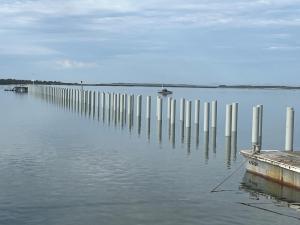
Wagners FRP piles installed at McLoughlins Jetty in Victoria ahead of the construction of the jetty super structure
The Trident Marine Pile – Designed for Motion and Impact
When you have rollers, pontoons, or floating walkways that move with the tide, the story changes. Those rollers can wear away coatings or abrade the surface of a standard FRP pile over time. That’s exactly why we developed the Trident Marine Pile.
It’s the same pultruded FRP core, but it’s encased in a high-density polyethylene (HDPE) sleeve which gives it a smooth, tough surface designed for direct contact with pile guide systems.
The HDPE sleeve provides a low-friction, impact-resistant barrier that protects the FRP from abrasion, while also allowing rollers to move freely along the pile. It’s bonded during manufacture, so the system acts as one composite unit; structurally robust, chemically inert, and fully sealed from the environment.
Typical technical characteristics

Data from Trident Marine Pile Technical Guide, 2024
Where it’s used
The Trident system is ideal for:
- Floating marinas and pontoons
- Gangways with roller-mounted systems
- Mooring piles under cyclic tidal motion
- Applications with high abrasion or impact exposure IE boat moorings
The sleeve doesn’t just protect the FRP it also protects rollers and pontoons by maintaining a consistent, smooth running surface. The result is a longer service life for both the pile and the equipment it interacts with.
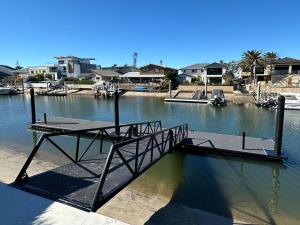
Private floating jetty in a residential canal on the Gold Coast in Queensland
Choosing the Right System
Both the standard FRP and TridentMarine Piles share the same FRP structural core and the difference lies in the interface with the operating environment.

If your structure doesn’t have rollers or mechanical movement, the standard FRP pile is the most efficient and cost-effective solution. If you do have rollers, the Trident Marine Pile’s HDPE sleeve is essential to prevent surface wear and extend service life.
Design and Installation
Both systems install much like conventional piles but because FRP is so lightweight, the whole process is faster, safer, and less costly.
- Driving and handling: FRP piles can be driven using standard vibratory or impact hammers. Their low weight reduces load on cranes and equipment, and their elastic resilience allows them to flex under impact without permanent deformation.
- Connections: For headstocks, pontoons or caps, we typically recommend marine grade stainless steel or composite hardware to maintain a corrosion-free system.
- Guide interfaces: For Trident piles, the guide diameter and spacing should match the sleeve geometry to ensure even load transfer and prevent localised wear.
Maintenance requirements are significantly less than traditional materials. The FRP core doesn’t corrode or rot, the HDPE sleeve resists abrasion, and the fluoropolymer coating on standard piles maintains gloss and colour without needing recoating.
Sustainability and Lifecycle Benefits
From a sustainability standpoint, composites have clear advantages. Every time you replace a steel or timber pile, you’re consuming energy, materials, and transport resources. By designing for a 50-year+ lifespan, we dramatically reduce that lifecycle impact.
Some of the sustainability benefits include:
- No corrosion coatings or toxic treatments required
- Lightweight installation, reducing energy use on-site
- Zero leaching or contamination into marine environments
- End-of-life recyclability — both FRP and HDPE can be reused or reprocessed
Simply put, fewer replacements mean less waste and less embodied carbon — without compromising strength or safety.
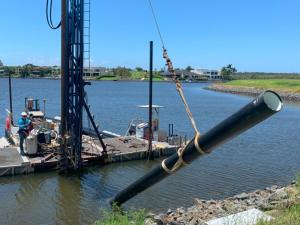
Lifting a Wagners FRP Trident Marine Pile onto the piling rig in a Gold Coast residential canal in Queensland
If you’re designing a fixed or static structure, go with the standard Wagners CFT FRP marine pile. If your system involves rollers, pontoons, or any kind of movement, choose the Trident Marine Pile.
Both options offer the same benefits of corrosion resistance, UV protection, light weight, and strength; the difference comes down to whether you need that additional HDPE protection layer for surface contact.
Either way, you’re choosing a solution that’s engineered to deliver long-term performance, sustainability, and peace of mind in the most challenging conditions.
Final Thoughts
The transition from traditional materials to composites is reshaping how we think about marine infrastructure. At Wagners CFT, we’re proud to be part of that shift helping engineers, contractors, and asset owners move toward smarter, longer-lasting, and more sustainable designs.
Whether you’re building a boardwalk, marina, or port facility, our FRP marine piles (both standard and Trident), offer a proven path to lower lifecycle costs, easier installation, and a truly corrosion-free future.
If you’d like to discuss which system suits your project best, I’d be happy to help.
— Darren Wilson Key Accounts Manager – Wagners Composite Fibre Technologies 📩 www.wagnerscft.com.au

